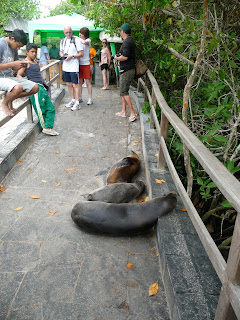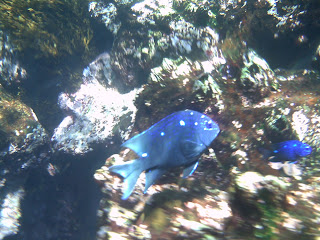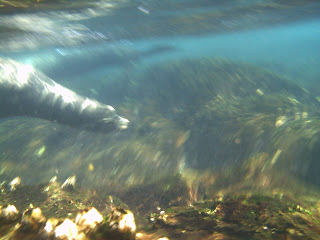When I was in elementary school I
did a report on the Galapagos tortoise: Giant reptiles reminiscent of the
dinosaurs teetering on the edge of extinction. Ever since then I have wanted to come to the Galapagos
Islands: the aspiring biologists equivalent of Disney world for kids or
Yosemite for climbers; a Mecca of biology in action. It was in the Galapagos Islands that Charles Darwin
developed and tested his theory on evolution and it’s easy to see why. The Galapagos Islands are one of (if
not the) most biodiverse regions in the entire world! Birds and reptiles especially are everywhere and since until
relatively recently the Galapagos Islands have been left mostly undisturbed by
humans the animals are curious and fearless. 98% of the Islands are a protected national park with only 2%
of the islands inhabited by humans.
My
first impression of the Galapagos Islands was the fauna. Baltra Island, a military base and
where the airstrip is located, was covered with cactus like something out of
the southwest United States. I
hadn’t expected that; I had expected green and lush landscapes. After taking a ferry to Santa Cruz
Island the green and lush landscapes greeted me; first the red mangroves in the
beach and then thousands of trees and plants in the higher ground with blooming
flowers of every shade imaginable everywhere. Within half an hour we arrived at a dairy farm in the
highlands. As we drove in we
spotted giant tortoises everywhere! They were chilling out with the cows,
lumbering down the road, and resting in the grass. We hiked for about an hour through the jungle-like highlands
taking pictures of the first hundred tortoises that easily outweighed me by 100
pounds. I never thought I would
see so many wild giant tortoises that I would not feel the need to take a
picture of all of them: it was quite an experience. Later, at our visit to the Charles Darwin research center we
would learn that despite seeing so many they are actually very threatened as a
species. Pirates and other sailors
hunted the tortoises nearly to extinction because they can survive for many
months without food or water providing the pirates at sea with fresh meat when
they needed it. In more recent
years, however, it has been the species introduced by humans that have done the
real damage. While adult tortoises
don’t have much to fear because of their thick shells, the goats and dogs dig
up and eat the eggs so far too few survive to adulthood. As a result many of the islands have
breeding centers where they collect the eggs of wild tortoises and keep them in
enclosed habitats until they are ready to be reintroduced to the wild.
 |
|




I
ate dinner at an open-air café a bit off the main street. The owners spoke no English. I was proud of myself for figuring out
how to ask what was on the hamburger especial but unfortunately I didn’t
understand the answer so I ordered it to find out. We are staying in hotel red booby named after the bird that
is endemic to the island.
My
second day in the islands we traveled to the largest of the islands, Isabella,
which is mostly uninhabited by humans and about a two hour boat ride from Santa
Cruz. As our boat pulled up to the
dock, numerous bright red and blue crabs skittered away. On the dock three sea lions and an
iguana were resting in the shade of the red mangroves. Sea lions are quite friendly and very
much like dogs: they want to play all the time! (More about that later). There are 4 species of iguanas endemic
to the islands (which means they live no where else in the world), three of
which are land iguanas and one of which is the marine iguana; which is the only
iguana in the world that gets its food in the water. The marine iguanas were everywhere!! On rocks, the dock, the
beaches… I probably saw a thousand marine iguanas in the last four days. We saw blue footed boobies and
Galapagos penguins, two other species endemic to the islands. We saw flamingos, white tipped sharks,
sea turtles, manta rays, and many other birds. After all that we went snorkeling. We saw fish in every different color and every different
size. My mom and I also found two
stingrays as big as I am! I tried to get a picture of me with them but
underwater photography is harder than it looks.




 |
| Blue footed Booby |
 |
| Galapagos Penguins and an Iguana |
 |
| A White tipped Shark |
 |
| Sea Turtle! |
 |
| Crab |
 |
| Marine Iguana |
 |
| Eagle Rays |
 |
| Flamingos |
 |
| Sting ray bigger than me |
 |
| Sting ray bigger than me: Underwater photography is harder than it looks |
The
third day in the islands we hiked 2.5 kilometers (1.5 miles) out to Tortuga
bay: a beautiful beach just like you would see in the movies. After spending the morning swimming and
harassing iguanas with our cameras we took a boat tour of the bay. The highlight of the trip so far was
snorkeling at La Loberia that afternoon.
As soon as we got in the water the sea lions lounging on the rocks
decided they wanted to play. I
spent the next hour swimming with sea lions darting around me, chasing me,
grabbing onto my foot, flipping over me, and coming up to me and looking me in
the eyes. I’ve always thought
swimming with the dolphins or the sea lions at sea world looked amazing but
this was in the wild and it was certainly one of the most memorable moments in
my life.













We
spent the rest of the afternoon as Las Grietas (in English cracks or
crevices). It was a natural
swimming hole about 200 feet long and 25 feet wide; with either side lined with
cliffs about 40 feet high. I
jumped about 10 times before we had to leave!
 |
| Our guide: Edilberto |
The
next day we took another 2-hour boat ride to Floreana Island, which is almost
completely uninhabited and home to more tortoises, birds, some awesome
geological features. All of the
islands were formed by volcanoes and are relatively new geologically
speaking. Air pockets in the
hardened lava collapsed to form caves, craters, and crevices all over the
place. Of course we snorkeled even
more and saw more awesome fish, another giant stingray, another sea turtle, and
some penguins. Although Floreana
is a good place to see hammerhead sharks, we unfortunately didn’t see any.
 |
| Sea lion hanging out by the pool |
 |
| Red Mangroves and an Iguana |
 |
| Iguana tracks |
 |
| Dolphins |
 |
| Another Sting Ray |
Our
final day in the Islands we visited a family owned coffee and sugar cane farm where
they produce sugar, coffee, and moonshine for the local market. They showed us the processes and we
sampled the products. It was like
it was 100 years behind. They had
just gotten electricity to run the machines to crush the sugar cane and all the
processing was done by hand.
Other notes:
-Conservation is taken seriously in Ecuador: there are far
more recycle bins than trashcans.
-Driving is definitely third world: traffic signs are just
suggestions, our bus precariously passed other cars on one lane roads, roads
were sometimes more rocks than gravel, we road on top of a bus for one tour (no
seats, just a luggage rack), we had to stop several times for tortoises
crossing the road.
-Most public bathrooms are BYOTP (bring your own toilet
paper) and some are BYOTS (bring your own toilet seat).
-Most businesses are family businesses; our bus driver had
his wife and kids on the bus, the coffee farm was a whole family affair, the
salt mine was run by a family, most shops are run by a family with the whole
family helping. Child labor laws
are apparently not present.
-I made a few friends from Argentina and Switzerland on our
tours. Emilio (from Argentina)
stayed at the same hotel as we did and he helped me with my Spanish each night.
-Probably less than 10% of the tourists at the Galapagos
Islands were from the US (at least on our tours), which is surprising since
it’s such a unique and exotic location (and perfect tropical vacation
destination) only 3 hours from Miami.
-It’s almost embarrassing how many Spanish speakers
understand and speak English; far more than English speakers that speak
Spanish. Also there doesn’t seem to
be the same animosity towards foreigners that there is in some places in the US;
on the contrary most locals were more than happy to help you in English or Spanish.
-If at all possible you have to come to the Galapagos
Islands sometime in your life! It is absolutely amazing; exotic animals,
beautiful scenery, friendly people, excellent seafood, perfect tropical beaches…
-Ecuador uses the US dollar but they also have their own
bills. If you spend $10 and pay
with a $20 you might get $5 US back and $5 in Ecuador’s cash.
-Locals gathered every night downtown to play soccer and
volleyball; It was a lot of fun to watch.
-If at all possible you have to come to the Galapagos
Islands sometime in your life! It is absolutely amazing; exotic animals,
beautiful scenery, friendly people, excellent seafood, perfect tropical beaches…












































































































